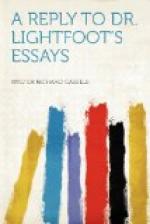It is clear from all this that we have no detailed information regarding the Diatessaron of Tatian. As Dr. Donaldson said long ago: “We should not be able to identify it, even if it did come down to us, unless it told us something reliable about itself.” [150:2]
We may now come to the documents recently published. The MS. of the Armenian version of the commentary ascribed to Ephraem is dated A.D. 1195, and Moesinger declares that it is translated from the Syriac, of which it is said to retain many traces. [150:3] He states that in the judgment of the Mechitarist Fathers the translation dates from about the fifth century, [150:4] but an opinion on such a point can only be received with great caution. The name of Tatian is not mentioned as the author of the “Harmony,” and the question is open as to whether the authorship of the commentary is rightly ascribed to Ephraem Syrus. In any case there can be no doubt that the Armenian work is a translation.
The Arabic work published by Ciasca, and supposed to be a version of Tatian’s Diatessaron itself, is derived from two manuscripts, one belonging to the Vatican Library and the other forwarded to Rome from Egypt by the Vicar Apostolic of the Catholic Copts. The latter MS. states, in notes at the beginning and end, that it is an Arabic translation of the Diatessaron of Tatian, made from the Syriac by the presbyter Abu-l-Pharag Abdullah Ben-at-Tib, who is believed to have flourished in the first half of the eleventh century, and in one of these notes the name of the scribe who wrote the Syriac copy is given, which leads to the conjecture that it may have been dated about the end of the ninth century. A note in the Vatican MS. also ascribes the original work to Tatian. These notes constitute the principal or only ground for connecting Tatian’s name with the “Harmony.”
So little is known regarding the Diatessaron of Tatian that even the language in which it was written is matter of vehement debate. The name would, of course, lead to the conclusion that it was a Greek composition, and many other circumstances support this, but the mere fact that it does not seem to have been known to Greek Fathers, and that it is very doubtful whether any of them, with the exception of Theodoret, had ever seen it, has led many critics to maintain that it was written in Syriac. Nothing but circumstantial evidence of this can be produced. This alone shows how little we really know of the original. The recently discovered works, being in Arabic and Armenian, even supposing them to be translations from the Syriac and that the Diatessaron was composed in Syriac, can only indirectly represent the original, and they obviously labour under fatal disability in regard to a restoration of the text of the documents at the basis of the work. Between doubtful accuracy of rendering and evident work of revision, the original matter cannot but be seriously disfigured.




